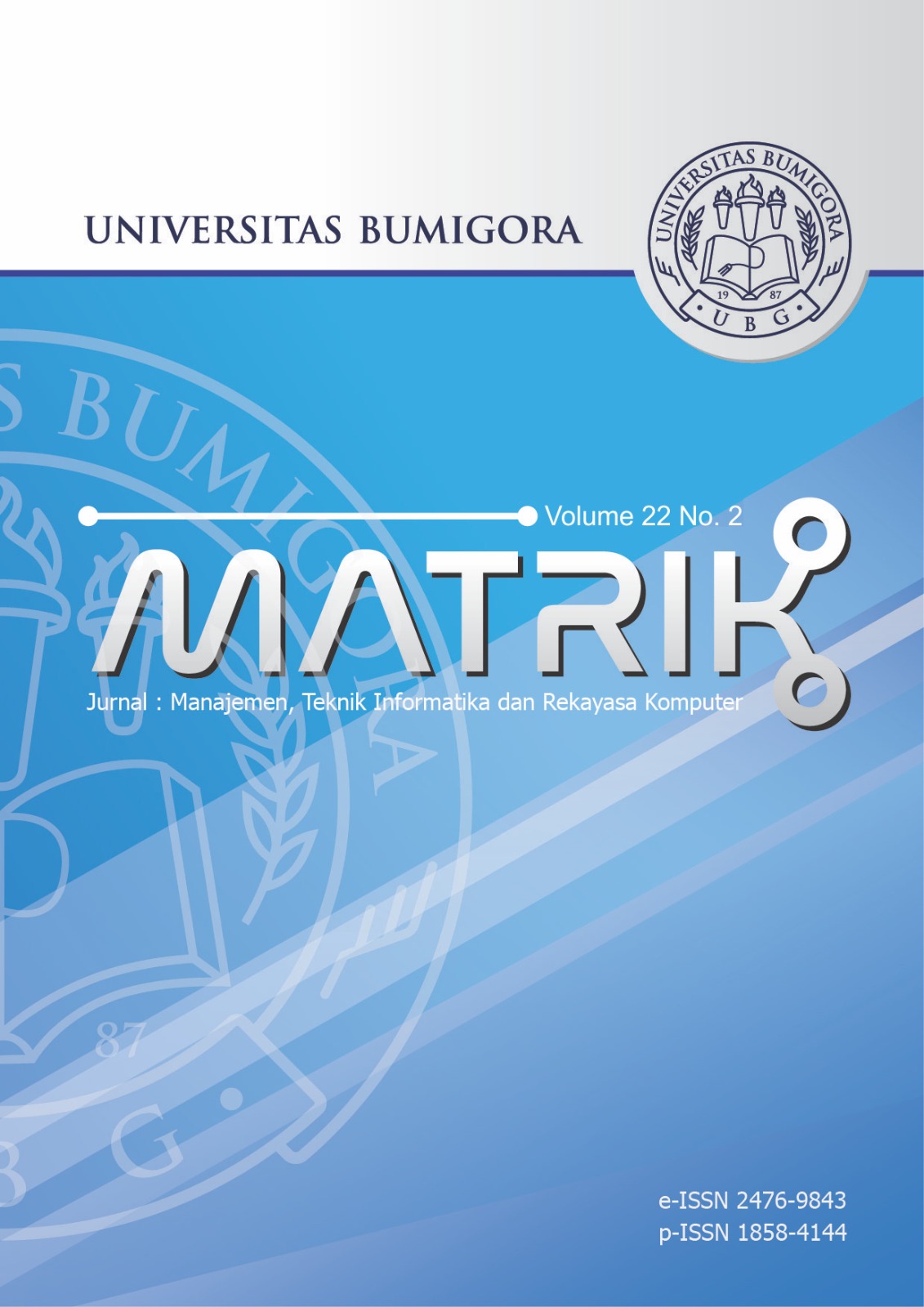A computational approach in analyzing the empathy to online donations during COVID-19
DOI:
https://doi.org/10.30812/matrik.v22i2.2396Keywords:
Computational social science, Empathy, Online donation, Twitter, COVID-19Abstract
The COVID-19 pandemic has a negative impact on many aspects of life. The global economic downturn is one of these negative consequences. Nonetheless, even though everyone feels the threat of this pandemic for themselves, some people still have the empathy to help others. An empirical analysis of this empathy attitude is expected to be a catalyst in realizing a social force for the community to work together to combat this pandemic. This study will look at how people felt about donating during the COVID-19 pandemic on Twitter. The goals of this study are to (1) compare differences in donor desire before and during the COVID-19 pandemic using the developed model, and (2) determine whether there is a significant difference in empathy for donating before and during the pandemic. This study employs computational social science (CSS) techniques to achieve this goal. The data was obtained from Twitter using the keyword "donation" in the 24 months preceding the pandemic and in the 24 months following the pandemic's arrival in Indonesia. Data analysis includes hypothesis testing using Mann-Whitney and Cohen's D statistical tests, showing a significant increase in online donation support among Indonesian Twitter users since the COVID-19 pandemic hit. From the results of data processing data obtained 159.995 data in accordance with the criteria to be analyzed. From the results of the Mann-Whitney test, all variables showed significant results between before and during the Covid-19 pandemic and in the results of the Cohen's d test, all variables got a large effect size. From the results of the two tests, it can open Twitter social media users who have increased empathy to donate during the Covid-19 pandemic in Indonesia
Downloads
References
Indonesia, Jakarta, 2021.
[2] Bappernas, Studi Pembelajaran Penanganan Covid-19 Indonesia, 2021.
[3] Peraturan Pemerintah RI, “Keputusan Presiden Republik Indonesia Nomor 12 Tahun 2020 tentang Penetapan Bencana Non-
Alam Penyebaran CORONA VIRUS DISEASE 2019 (COVID-19) sebagai Bencana Nasional.†2020.
[4] T. A. van den Broek, A. Need, M. L. Ehrenhard, A. Priante, and D. Hiemstra, “The Influence of Network Structure and Prosocial
Cultural Norms on Charitable Giving: A Multilevel Analysis of Movember’s Fundraising Campaigns in 24 Countries,†Social
Networks, vol. 58, no. April, pp. 128–135, 2019.
[5] Kominfo, “Indonesia Peringkat Lima Pengguna Twitter,†2012.
[6] F. M. Firmansyah and J. J. Jones, Did the Black Panther Movie Make Blacks Blacker? Examining Black Racial Identity on
Twitter Before and After the Black Panther Movie Release. Springer International Publishing, 2019, vol. 11864 LNCS.
[7] A. Kartino, M. Khairul Anam, Rahmaddeni, and Junadhi, “Analisis Akun Twitter Berpengaruh Terkait Covid-19 Menggunakan
Social Network Analysis,†Rekayasa Sistem dan Teknologi Informasi, vol. 5, no. 4, pp. 697–704, 2021.
[8] R. A. Abbasi, O. Maqbool, M. Mushtaq, N. R. Aljohani, A. Daud, J. S. Alowibdi, and B. Shahzad, “Saving Lives Using Social
Media: Analysis of the Role of Twitter for Personal Blood Donation Requests and Dissemination,†Telematics and Informatics,
vol. 35, no. 4, pp. 892–912, 2018.
[9] E. Mnif, K. Mouakhar, and A. Jarboui, “Blockchain Technology Awareness on Social Media: Insights from Twitter Analytics,â€
The Journal of High Technology Management Research, vol. 32, no. 2, p. 100416, nov 2021.
[10] H. H. Hidayat, A. Ardiansyah, P. Arsil, and L. I. Rahmawati, “Pemetaan Kata Kunci dan Polaritas Sentimen Pengguna Twitter
terhadap Kehalalan Produk,†MATRIK : Jurnal Manajemen, Teknik Informatika dan Rekayasa Komputer, vol. 21, no. 1, pp.
1–10, nov 2021.
[11] R. N. Aldekhyyel, S. Binkheder, S. N. Aldekhyyel, N. Alhumaid, M. Hassounah, A. AlMogbel, and A. A. Jamal, “The Saudi
Ministries Twitter Communication Strategies During the COVID-19 Pandemic: A Qualitative Content Analysis Study,†Public
Health in Practice, vol. 3, no. June, pp. 1–9, jun 2022.
[12] M. Kfoury, D. Landy, and S. Fourmentin, “Combination of DES and Macrocyclic Host Molecules: Review and Perspectives,â€
Current Opinion in Green and Sustainable Chemistry, vol. 36, no. August, p. 100630, aug 2022.
[13] S. Hinduja, M. Afrin, S. Mistry, and A. Krishna, “Machine Learning-Based Proactive Social-Sensor Service for Mental Health
Monitoring Using Twitter Data,†International Journal of Information Management Data Insights, vol. 2, no. 2, pp. 1–9, nov
2022.
[14] H. S. Hota, D. K. Sharma, and N. Verma, Lexicon-Based Sentiment Analysis Using Twitter Data. Elsevier Inc., 2021.
[15] A. Al-Thubaity, Q. Alqahtani, and A. Aljandal, “Sentiment Lexicon for Sentiment Analysis of Saudi Dialect Tweets,†in Procedia
Computer Science, vol. 142. Elsevier B.V., 2018, pp. 301–307.
[16] F. A. Effendi and Y. Sibaroni, “Sentiment Classification for Film Reviews by Reducing Additional Introduced Sentiment Bias,â€
Jurnal RESTI (Rekayasa Sistem dan Teknologi Informasi), vol. 5, no. 5, pp. 863 – 875, 2021.
[17] N. P. Dewi and Ubaidi, “Lexical Rule dan Pengaruh Penggunaan Lexicon pada Pos,†Matrix, vol. 18, no. 1, pp. 65–72, 2018.
[18] T. Sriwidadi, “Penggunaan Uji Mann-Whitney pada Analisis Pengaruh Pelatihan Wiraniaga dalam Penjualan Produk Baru,â€
Binus Business Review, vol. 2, no. 2, pp. 751–762, nov 2011.
[19] A. Bowring, F. J. Telschow, A. Schwartzman, and T. E. Nichols, “Confidence Sets for Cohen’s d Effect Size Images,†NeuroImage,
vol. 226, no. February, pp. 1–28, feb 2021.
[20] F. M. Firmansyah and A. R. Pratama, “Anonymity in COVID-19 Online Donations: A Cross-Cultural Analysis on Fundraising
Platforms,†in Advances in Intelligent Systems and Computing, 2021, vol. 1364, no. April, pp. 34–47.
[21] F. Koto and G. Y. Rahmaningtyas, “Inset Lexicon: Evaluation of AWord List for Indonesian Sentiment Analysis in Microblogs,â€
in Proceedings of the 2017 International Conference on Asian Language Processing, IALP 2017, 2018, pp. 391–394.
[22] N. Rihhadatul’aisyi, S. Muthmainnah, H. P. Zahra, T. W. Putri, and F. T. Febrian, “Efek Twitter di Masa Pandemi COVID-19
pada Sikap dan Perilaku,†Jurnal Ilmu Komunikasi, vol. 19, no. 2, pp. 205–220, oct 2021.
[23] D. Purwitasari, A. Apriantoni, and A. B. Raharjo, “Identifikasi Pengaruh Pandemi Covid-19 terhadap Perilaku Pengguna Twitter
dengan Pendekatan Social Network Analysis,†Jurnal Teknologi Informasi dan Ilmu Komputer, vol. 8, no. 6, pp. 1309–1318,
nov 2021.
Downloads
Published
Issue
Section
How to Cite
Similar Articles
- Andris Faesal, Aziz Muslim, Aditya Hastami Ruger, Kusrini Kusrini, Sentimen Analisis pada Data Tweet Pengguna Twitter Terhadap Produk Penjualan Toko Online Menggunakan Metode K-Means , MATRIK : Jurnal Manajemen, Teknik Informatika dan Rekayasa Komputer: Vol. 19 No. 2 (2020)
- Fitra Ahya Mubarok, Mohammad Reza Faisal, Dwi Kartini, Dodon Turianto Nugrahadi, Triando Hamonangan Saragih, Gender Classification of Twitter Users Using Convolutional Neural Network , MATRIK : Jurnal Manajemen, Teknik Informatika dan Rekayasa Komputer: Vol. 23 No. 1 (2023)
- Indra Indra, Nur Aliza, Detecting Disaster Trending Topics on Indonesian Tweets Using BNgram , MATRIK : Jurnal Manajemen, Teknik Informatika dan Rekayasa Komputer: Vol. 23 No. 1 (2023)
- Siti Ummi Masruroh, Cong Dai Nguyen, Doni Febrianus, Comparative Analysis of TF-IDF and Modern Text Embedding for the Classification of Islamic Ideologies on Indonesian Twitter , MATRIK : Jurnal Manajemen, Teknik Informatika dan Rekayasa Komputer: Vol. 25 No. 1 (2025)
- Ni Putu Nanik Hendayanti, Maulida Nurhidayati, Siti Soraya, Habib Ratu Perwira Negara, Community Purchase Decision Modeling in Bali with Non-Linier Methods , MATRIK : Jurnal Manajemen, Teknik Informatika dan Rekayasa Komputer: Vol. 21 No. 3 (2022)
- Annisa’ul Mubarokah, Rita Ambarwati, Dedy Dedy, Mashhura Toirхonovna Alimova, Unsafe Conditions Identification Using Social Networks in Power Plant Safety Reports , MATRIK : Jurnal Manajemen, Teknik Informatika dan Rekayasa Komputer: Vol. 23 No. 2 (2024)
- Supangat Supangat, Mohd Zainuri Bin Saringat, Mochamad Yovi Fatchur Rochman, Predicting Handling Covid-19 Opinion using Naive Bayes and TF-IDF for Polarity Detection , MATRIK : Jurnal Manajemen, Teknik Informatika dan Rekayasa Komputer: Vol. 22 No. 2 (2023)
- Melati Rosanensi, Improving E-Commerce Effectiveness Using Augmented Reality , MATRIK : Jurnal Manajemen, Teknik Informatika dan Rekayasa Komputer: Vol. 19 No. 2 (2020)
- Zein Zein, Ahmat Adil, APLIKASI MEDIA BANTU PEMBELAJARAN KRIPTOGRAFI DENGAN MENGGUNAKAN ALGORITMA MESSAGE DIGEST 5 (MD5) , MATRIK : Jurnal Manajemen, Teknik Informatika dan Rekayasa Komputer: Vol. 15 No. 2 (2016)
- Abulwafa Muhammad, Sarjon Defit, Analyzing the use of Social Media by Fashion Designers with K-Means and C45 , MATRIK : Jurnal Manajemen, Teknik Informatika dan Rekayasa Komputer: Vol. 21 No. 2 (2022)
You may also start an advanced similarity search for this article.


.png)












